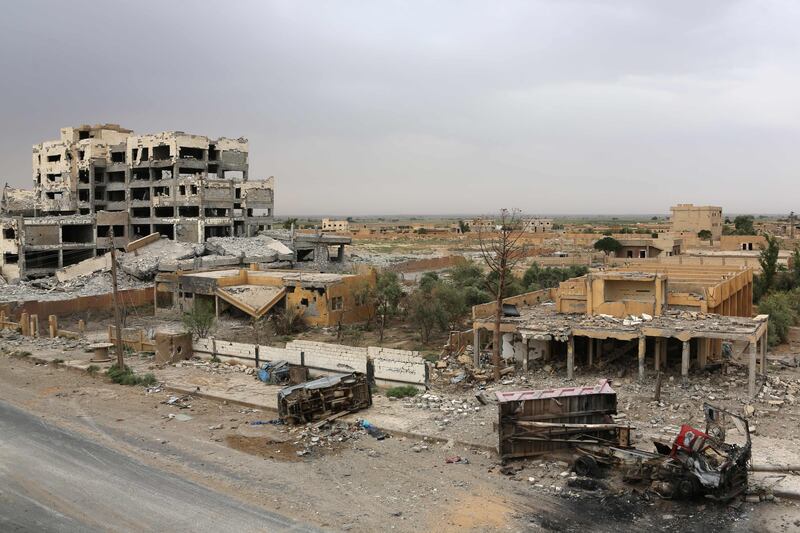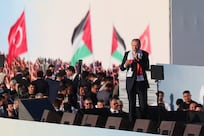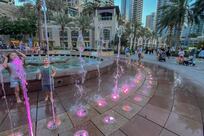The Syrian regime and its allies began a slow push into eastern Syria in March. Having recaptured Palmyra that month, pro-government forces increased their presence in the sparsely populated Syrian desert and ultimately reached the borders near Iraq and Jordan by mid-June.
The push to establish what was dubbed by media as a “land bridge”, linking Iran’s allies in Syria and Iraq, disrupted any prospect for an American-led ground assault against ISIL from the Syrian desert. Instead, the United States-led coalition would have to focus on expanding its campaign against the group from southern Hasakah in the north-east.
Forces aligned with the Syrian regime continued their slow march into Deir Ezzor. Division of labour between Russia and Iran enabled these forces to open a supply line into Deir Ezzor, then under siege since 2014. Iran significantly expanded its support for the ground campaign to seize key outposts in the road networks along the way. For example, Hizbollah-aligned Mayadeen TV featured what it described as the first footage of Iran's Islamic Revolutionary Guard Corps fighting against ISIL to have been officially released. (Previously, Tehran had insisted it only had "advisers" operating along the Syrian Arab Army, not as fighting units.)
By the first week of September, the pro-government forces announced that they broke the siege around Deir Ezzor, which compelled the US-backed Syrian Democratic Forces on September 9 to start their own campaign to expel ISIL from Deir Ezzor, even though the operation was scheduled for later. One of the US concerns was that Iranian-backed forces could advance towards the Iraqi border, close off the area and potentially disrupt the SDF's ability to move south — as they did near Palmyra.
_______________________
Read more from Opinion
[ Russia may have saved the Assad regime. But its real ally has been terrorism ]
[ The human cost of leaving Bashar Al Assad in power is before us ]
_______________________
At this point, though, Russia and Iran managed to establish a sprawling corridor throughout the Syrian desert to enable the expansion inside Deir Ezzor, and potentially to march down to the city of Mayadeen and the oil-rich countryside on the other side of the Euphrates River before the US reaches it. Before launching an offensive to recapture the urban neighbourhoods inside the city of Deir Ezzor, Russia moved to secure the strategic airport to its south and to cross the river. It built two bridgeheads to link the two river banks near the airport.
Then something unanticipated happened. A counter-offensive by ISIL undid much of the work and heavy lifting by both Iran and Russia in the areas around Deir Ezzor and Palmyra over the past five months. ISIL recaptured several enemy outposts and the pro-government force's defences began to crumble in some areas. The counterattacks significantly disrupted the flow of the Russian and Iranian plan for Deir Ezzor, and demonstrated that the gains made in that region were fragile and largely inflated.
Clashes continue, and the regime’s allies will probably regain the initiative and reverse ISIL’s advances. But the episode should give observers pause about the regime’s capabilities. Despite the significant gains made by those forces, the regime failed to protect the areas liberated from ISIL while Iran and Russia surged forward.
The fighting in that region, including in Palmyra, has been spearheaded by Iran-supplied forces. Both Russian and Iranian forces suffered high-level casualties in the clashes. Those include senior IRGC officers killed during a series of hit-and-run ISIL operations against their bases near the border. Lt Gen Valery Asapov, head of the 5th army in Russia's eastern command, was killed in the area where forces he commanded built a bridge near the Deir Ezzor airport. On Tuesday, ISIL also released a video of two Russian soldiers it said it had captured during its counter-offensive last week.
The method in which such losses were inflicted highlights another problem for these forces, namely that the losses were made in large part because one side knows the terrain better than the other. The senior Iranian officers were killed in surprise attacks on their bases. The Russian soldiers were captured in Al Shula, as ISIL made its way into the desert town. Al Qaryatayn, a significant city that changed hands a number of times, was reportedly recaptured by ISIL with the help of sleeper cells and support from some of the population.
_______________
More from Hassan Hassan
[ Terrorists hijacked a single verse to justify their crimes. It's time to match their vigour ]
[ The story of Hayat Tahrir Al Sham's rise to prominence and what it means for Syria ]
_______________
Gains made in recent months, mostly due to a surge in support by Iran and Russia, were widely celebrated by the regime and its allies. These gains also shaped much of the narrative about the regime and its capabilities in this period. But those gains were clearly fragile, as this author has frequently pointed out. The setbacks should serve as a reminder that the regime-aligned forces have a long way to go before they could win the war. This war will not be won by a “temp army” supplied by Damascus’s backers if the regime is unable to keep the gains.
The lesson is not limited to the Russian camp. The US has similar, even worse, illusions about its war against jihadis. The fight against ISIL in that region is not necessarily harder than elsewhere. It can be easier. The problem is that both campaigns are led largely by complete strangers, while jihadis have their eyes fixed on that border area.
Judging from other precedents during the conflict, though, the lessons that should be learned from the ISIL counter-offensive and the regime gains over past few months will be soon forgotten. Headlines will go back to portraying a resurgent regime that could win back the country. In the meantime, the situation will only get worse.
Hassan Hassan is a senior fellow at the Tahrir Institute for Middle East Policy





